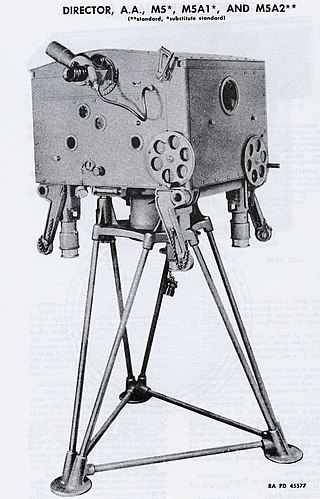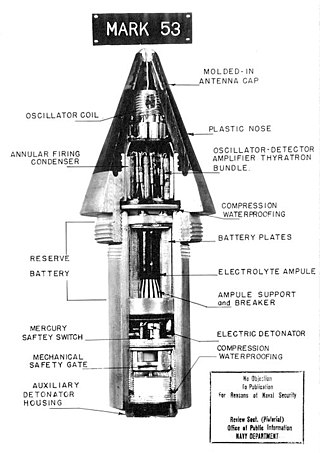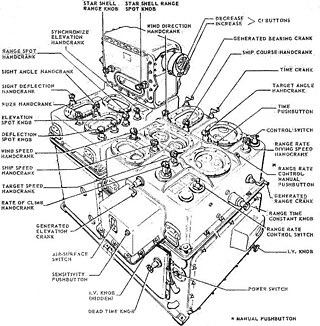
The Kerrison Predictor was one of the first fully automated anti-aircraft fire-control systems. It was used to automate the aiming of the British Army's Bofors 40 mm guns and provide accurate lead calculations through simple inputs on three main handwheels.

A proximity fuze is a fuze that detonates an explosive device automatically when it approaches within a certain distance of its target. Proximity fuzes are designed for elusive military targets such as airplanes and missiles, as well as ships at sea and ground forces. This sophisticated trigger mechanism may increase lethality by 5 to 10 times compared to the common contact fuze or timed fuze.

The 90 mm gun M1/M2/M3 was an American heavy anti-aircraft and anti-tank gun, playing a role similar to the German 8.8cm Flak 18. It had a 3.5 in (90 mm) diameter bore, and a 50 caliber barrel, giving it a length of 15 ft (4.6 m). It was capable of firing a 3.5 in × 23.6 in shell 62,474 ft (19,042 m) horizontally, or a maximum altitude of 43,500 ft (13,300 m).
Ivan Alexander Getting was an American physicist and electrical engineer, credited with the development of the Global Positioning System (GPS). He was the co-leader of the research group which developed the SCR-584, an automatic microwave tracking fire-control system, which enabled M9 Gun Director directed anti-aircraft guns to destroy a significant percentage of the German V-1 flying bombs launched against London late in the Second World War.

A fire-control system (FCS) is a number of components working together, usually a gun data computer, a director and radar, which is designed to assist a ranged weapon system to target, track, and hit a target. It performs the same task as a human gunner firing a weapon, but attempts to do so faster and more accurately.

The SCR-268 was the United States Army's first radar system. Introduced in 1940, it was developed to provide accurate aiming information for antiaircraft artillery and was also used for gun laying systems and directing searchlights against aircraft. The radar was widely utilized by both Army and Marine Corps air defense and early warning units during World War II. By the end of World War II the system was already considered out of date, having been replaced by the much smaller and more accurate SCR-584 microwave-based system.

The SCR-584 was an automatic-tracking microwave radar developed by the MIT Radiation Laboratory during World War II. It was one of the most advanced ground-based radars of its era, and became one of the primary gun laying radars used worldwide well into the 1950s. A trailer-mounted mobile version was the SCR-784.

Hendrik Wade Bode was an American engineer, researcher, inventor, author and scientist, of Dutch ancestry. As a pioneer of modern control theory and electronic telecommunications he revolutionized both the content and methodology of his chosen fields of research. His synergy with Claude Shannon, the father of information theory, laid the foundations for the technological convergence of the information age.
The gun data computer was a series of artillery computers used by the U.S. Army for coastal artillery, field artillery and anti-aircraft artillery applications. For antiaircraft applications they were used in conjunction with a director computer.
Operation Diver was the British codename for countermeasures against the V-1 flying bomb campaign launched by the German Luftwaffe in 1944 against London and other parts of Britain. Diver was the codename for the V-1, against which the defence consisted of anti-aircraft guns, barrage balloons and fighter aircraft.

The Mark 1, and later the Mark 1A, Fire Control Computer was a component of the Mark 37 Gun Fire Control System deployed by the United States Navy during World War II and up to 1991 and possibly later. It was originally developed by Hannibal C. Ford of the Ford Instrument Company. and William Newell. It was used on a variety of ships, ranging from destroyers to battleships. The Mark 37 system used tachymetric target motion prediction to compute a fire control solution. It contained a target simulator which was updated by further target tracking until it matched.

A director, also called an auxiliary predictor, is a mechanical or electronic computer that continuously calculates trigonometric firing solutions for use against a moving target, and transmits targeting data to direct the weapon firing crew.

The Radiation Laboratory, commonly called the Rad Lab, was a microwave and radar research laboratory located at the Massachusetts Institute of Technology (MIT) in Cambridge, Massachusetts. It was first created in October 1940 and operated until 31 December 1945 when its functions were dispersed to industry, other departments within MIT, and in 1951, the newly formed MIT Lincoln Laboratory.
The Mark 8 Fire Control Computer was developed by Bell Laboratories during World War II. It was initially requested by the USN Bureau of Ordnance as an alternative to the Ford Instruments Mark I Fire Control Computer, in case supplies of the Mk I were interrupted or were unable to be manufactured in the required numbers. The Mk 8 computer used all electric methods of computation, in contrast to the Mk 1, which performed most computations via mechanical devices. The Mk 8 was found to be more accurate than the Mk 1 and substantially faster in reaching a fire control solution, but by the time it was developed and tested in 1944, supplies of the Mk 1 were found to be sufficient in quantity. The USN extensively tested the Mk 8 and may have incorporated some of its technology into the post war Ford Instruments Mk1A computer. The Mk 8 technology was similar to that used in the M9 gun data computer used by the US Army for coast defence fire control and in the SCR-584 radar system computer.

Lee L. Davenport was an American physicist. He was a member of the MIT Radiation Laboratory during World War II, responsible for the development and deployment of the SCR-584 radar system.
The Western Electric M-33 Antiaircraft Fire Control System was an X-Band "Gunfire Control Radar", for aiming antiaircraft artillery by computer control. Developed for mobility via 3 trailers, the "M-33 system could compute, for the 90-mm. and 120-mm. guns, firing data for targets with speeds up to 1,000 mph", and for targets at 120,000 yards had similar gun laying accuracy as "SCR-584 type radars" at 70,000 yards. The system included a telescopic "target selector" on a tripod near the guns for additional measurement of aircraft "azimuth and elevation data [to] be transmitted to the computer and utilized as gun directing data."

Radar, Anti-Aircraft Number 3 Mark 7, also widely referred to by its development rainbow code Blue Cedar, was a mobile anti-aircraft gun laying radar designed by British Thomson-Houston (BTH) in the mid-1940s. It was used extensively by the British Army and was exported to countries such as Holland, Switzerland, Sweden Finland and South Africa. In British service, it was used with the 5.25 inch and QF 3.7 inch AA guns, as well as the Brakemine missile.

435th (Mixed) Heavy Anti-Aircraft Battery was an air defence unit of Britain's Royal Artillery formed during World War II. It was the first 'Mixed' battery in which women of the Auxiliary Territorial Service were integrated into the unit's personnel and was the forerunner of hundreds of later batteries. It defended the United Kingdom against aerial attack until it deployed to Belgium in January 1945 to defend Brussels against V-1 flying bombs.
The 2nd 90mm Antiaircraft Artillery Gun Battalion was a United States Marine Corps antiaircraft unit that was active during the 1940s & 1950s. Originally formed during World War II as the 9th Defense Battalion, the battalion took part in combat operations on Guadalcanal, Rendova, Munda Point, and Guam. Like most other Marine defense battalions, the unit was re-designated in September 1944, becoming the 9th Antiaircraft Artillery Battalion. Returning to the United States in 1946, the battalion was again re-designated, this time as the 1st Antiaircraft Artillery Battalion. The battalion received its final designation as the 2nd 90mm Antiaircraft Artillery Battalion on August 21, 1950. It was later decommissioned on September 15, 1956 at Marine Corps Base 29 Palms, California.

The AN/CPS-1, also known as the Microwave Early Warning (MEW) radar, was a semi-mobile, S band, early-warning radar developed by the MIT Radiation Laboratory during World War II. It was one of the first projects attempted by the Lab and was intended to build equipment to transition from the British long-wave radar to the new microwave centimeter-band radar made possible by the cavity magnetron. This project, led by Luis Walter Alvarez, became the world's first microwave phased-array antenna.














